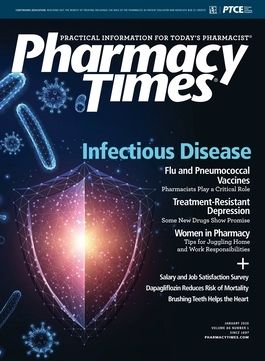Publication
Article
Pharmacy Times
Encourage Patients to Get Flu and Pneumococcal Vaccines
Author(s):
Pharmacists play a critical role in protecting patients from seasonal influenza and pneumonia illnesses and sequelae.
Pharmacists’ position as accessible health care professionals affords them the ideal opportunity to remind patients to stay up-to-date on immunizations.
Every season, pharmacies embark on a major outreach to immunize the public against influenza and pneumonia. It is imperative that pharmacists understand the recommendations put forth by the CDC for each season’s vaccines. Pharmacists also need to know which vaccines are available; be able to combat misconceptions about vaccines; and, by making strong recommendations, help increase the number of patients receiving these immunizations.
FLU VACCINES
The inuenza virus infects the lungs, nose, and throat, causing a highly contagious respiratory illness. Flu symptoms can be mild to severe, leading to hospitalization and possibly death.
Anyone can get the flu, which can cause serious problems at any age. However, some people are at increased risk of complications, such as the elderly; pregnant women; those with chronic medical conditions, such as asthma, diabetes, or heart disease; and young children.
The best way to prevent the flu is by getting vaccinated every year. About 2 weeks after a patient receives the flu vaccine, antibodies that protect against the influenza virus are formed. This can reduce doctors' visits, flu illnesses, and absences from school and work. In addition, the vaccine can lessen the severity of the flu and prevent flu-related deaths and hospitalizations.
Current Recommendations
The CDC recommends that everyone older than 6 months receive the inuenza vaccine every year. The agency also advises immunizing from the end of August through October to achieve the greatest benet, based on the months that most cases of inuenza develop.
Vaccination types for the 2019-2020 flu season are:
- Live attenuated influenza vaccine: intranasal; indicated for healthy, nonpregnant people aged 2 through 49 years.1
- Quadrivalent cell culture-based inactivated influenza vaccine: injectable; manufactured using cell culture rather than eggs; indicated for people 4 years and older.1
- Quadrivalent inactivated influenza vaccine: injectable: contains influenza A(H1N1) and (H3N2) and 2 influenza B lineage viruses, predicted to be the most common; indicated for everyone 6 months and older.1
- Quadrivalent recombinant influenza vaccine: injectable; produced without the use of eggs; contains influenza A(H1N1) and (H3N2) and 2 influenza B lineage viruses, predicted to be most common; indicated for adults.1
- Trivalent adjuvanted inactivated influenza vaccine: injectable; contains MF59 adjuvant and is designed to promote a stronger immune response in older adults; contains influenza A(H1N1) and (H3N2) and 2 influenza B lineage viruses, predicted to be most common; indicated for adults 65 years and older.1
- Trivalent high-dose inactivated influenza vaccine: injectable; contains 4 times the antigen of a standard-dose influenza vaccine and aims to promote a stronger immune response in older adults; contains influenza A(H1N1) and (H3N2) and 2 influenza B lineage viruses, predicted to be most common; indicated for adults 65 years and older.1
Common Misconceptions
Many patients mistakenly believe that the flu vaccine causes flu illness. Flu shots are made with either a “killed” virus that is not infectious or a single gene from the virus to produce an immune response without causing infection.2
Some people report not feeling well after receiving the flu vaccine. This occurs simply because the body is adjusting to introduction of the antigen and triggers an immune response, which may cause headache, low-grade fever, and muscle aches. Symptoms usually last 1 to 2 days.2
Unfortunately, the flu vaccine is not 100% effective. People who are vaccinated may get ill for several reasons: They may have another respiratory virus that causes flulike symptoms, were exposed to the flu shortly before or after receiving the vaccine—it takes 2 weeks for the body to make antibodies—or be infected with a strain that is not covered by that season’s vaccine.
Finally, there is variability between people on the flu vaccine’s effectiveness.2
PNEUMONIA VACCINES
More than 250,000 people in the United States are hospitalized every year with pneumonia, a bacterial infection of the lungs, and about 20% of those patients die.3
Anyone can get pneumonia, which can cause serious problems at any age. Some people are at increased risk of pneumonia complications, such as the elderly; people who smoke; those with chronic medical conditions, such as asthma, diabetes, or heart disease; and young children.
Current Recommendations
In the United States, 2 pneumococcal vaccines are licensed for use by the FDA: pneumococcal conjugate vaccine (PCV13 [Prevnar 13]) and pneumococcal polysaccharide vaccine (PPSV23 [Pneumovax 23]).
The CDC recommends the pneumococcal conjugate vaccine for adults 65 years and older, all children younger than 2 years, and people aged 2 to 64 years with chronic health conditions.
In children, these conditions include chronic heart, kidney, liver, or lung disease; diabetes; HIV infection; immune-compromising diseases; nephrotic syndrome; and sickle cell disease.
Adults share those contraindications plus an absent or damaged spleen, AIDS or HIV infection, alcoholism, cancer, and cigarette smoking.3
The CDC recommends the pneumococcal polysaccharide vaccine for everyone 65 years and older, adults aged 19 to 64 who smoke cigarettes, and people aged 2 to 64 years with the high-risk conditions listed above.3
STRENGTHENING THE CASE
Most adult patients think that vaccines are important, but they sometimes need a strong reminder to get vaccinated. To help health care professionals present the case for vaccination, the CDC has come up with the mnemonic SHARE:
- Share the reasons a vaccine is the right choice for that patient based on his or her age, health status, lifestyle, occupation, or other risk factors.
- Highlight positive experiences with vaccines (personal and/or in the practice), as appropriate, to reinforce the benefits and strengthen confidence in vaccination.
- Address patient concerns and questions about vaccines, including adverse effects, effectiveness, and safety, at a level they understand. This is also a good time to dispel some of the misconceptions that patients may have.
- Remind patients that vaccines protect them and their loved ones from diseases and their potentially serious complications.
- Explain the potential consequences of vaccine-preventable diseases, including monetary costs and serious health effects.
PREVENTION POINTERS
Up-to-date immunizations are the best protection against the flu and pneumonia. In addition, avoid contact with sick people; do not touch the eyes, mouth, and nose; clean and disinfect possibly contaminated surfaces; and wash hands often with soap and water.
To help keep an infected person’s illness from spreading, clean and disinfect contaminated surfaces, cover the mouth and nose with a tissue when coughing or sneezing, limit contact with others, stay home at least 24 hours after fever has gone, and wash hands often with soap and water.
REFERENCES
- Make a strong u vaccine recommendation. CDC website. cdc.gov/u/professionals/vaccination/u-vaccine-recommendation.htm. Updated November 5, 2019. Accessed December 14, 2019.
- Misconceptions about seasonal u and u vaccines. CDC website. cdc.gov/u/prevent/misconceptions.htm. Updated September 25, 2019. Accessed November 2, 2019.
- Pneumococcal vaccine. CDC website. cdc.gov/vaccines/vpd/pneumo/index.html. Updated November 21, 2019. Accessed December 14, 2019.







